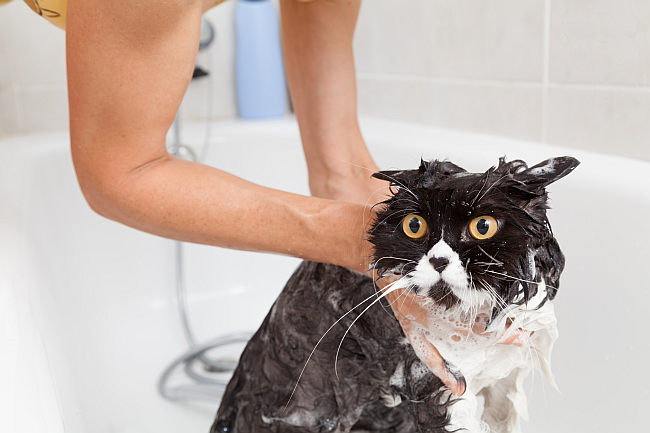Shampooing
How often should I shampoo my pet?
There may be a variety of opinions on the subject, but it seems that the general consensus is that bathing a dog once a week, or even once every two weeks could be too drying for their skin. The best plan would be to try to bathe the dog or cat about every 5-8 weeks.
How do you keep them clean in between baths?
During the “off weeks” between giving your pet a bath, you ought to keep up the other aspects of hygiene. Continue brushing the cat or dog’s teeth, combing his coat, and using care wipes to clean out his ears, and any creases in the face. You can also use spray-over shampoo mists and wipes which will keep the fur clean, without drying out the scalp. These will help remove any dirt of dust collecting on the coat, and will stave off infection or bacteria from building up.
Can you use human shampoo for dogs?
This is not advisable. Though most products could be harmless to use in a pinch, we do not recommend sharing shampoos as a regular practice. The scents can be overpoweringly strong for the dog, and drying for his skin. Pet shampoos will help a dog’s fur and scalp maintain a balanced pH, instead of stripping the skin of oils or adding acidity. Human shampoos can also cause itchy rashes, hives, or peeling from being too strongly scented (which is another reason why dogs roll in things that stink!)
Which kinds of pet shampoos are best?
There are many kinds of useful pet shampoos, from gentle oatmeal washes, to medicated scrubs, whitening shampoos for light-coated pets, flea shampoos, moisturizing shampoos and hypoallergenic products to use. Try to avoid highly fragrant soaps, or even using strong medical soaps on a regular basis. Natural products, moisturizing shampoos are much safer to use for better long-term results.
Conditioning
Is pet conditioner necessary?
For most dogs, conditioner is not strictly necessary. But applying spray conditioners over a dog’s coat makes it much easier to brush or detangle, and also tends to make it smoother and shinier once dried. Different pet conditioners do different things, some cause hair to lie down smoothly, some enrich the hair with proteins, while others add extra shine and build up the scalps hydration. Talk to your groomer about the best option for your specific dog breed.
Should I do leave-in conditioners or rinse-out ones?
This is a matter of personal preference based on the amount of convenience and involvement you are willing to devote. Spray conditioners and leave-in options are more efficient, while wash-out conditioners are less likely to have buildup or leave hands feeling oily if over-applied. (Note, we do not recommend using human conditioners on pets as these can be heavy, too aromatic, and can alter an animal’s pH balance.)
Blow Drying
Should I use a blow drier on my pet?
When applied appropriately, there is no reason that blow drying a pet should be off-limits. Bear in mind that this method is not acceptable to all animals, and depending on your cat or dog’s sensitivity to sound and fur disruption, they may not be welcoming to the idea. Be willing to work with your pet to find what his comfort level is.
Are there any risks involved?
Certainly. Using any tool when grooming your pet will always present some kind of risk. However, blow driers are only dangerous if they are used on a high heat, or for too long a period. If blow drying is done too frequently, it can diminish the pet’s natural oils, causing flakiness and irritation on the skin, or potentially cause the pet to become overheated and uncomfortable. Some pets might feel a heightened sense of stress about the blow drier’s noise being near their ears and skin. The noise of a hair drier can be very alarming at first, so we recommend inviting the pet into your bathroom several times when you dry your hair before you attempt to groom the cat or dog with the drier. This will help accustom your pet to the sound so that he will be less likely to panic when it’s his turn.
When and how should I blow dry?
After bath-time, first towel-dry your cat or dog to soak up as much moisture as you can. Then select the “cool” setting on the drier. (If the pet begins to shiver in the process, switch to a warmer setting, but be mindful of how close the direr gets to the skin, and how long you are using it.)
Keep a fair distance from the skin, and move the drier back and forth predictably across the whole body. Make sure to only use the blow drier for brief intervals of time, in a well-ventilated room, so that your fur-coat wearing pet won’t swoon from the heat.
Blow driers are helpful in the winter to help avoid a cat or dog getting chilled after being damped by a bath. They also remove any lingering water retention in the hair, which would cause lint and dust to cling to the soppy fur.


